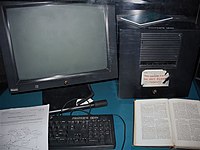From gopher to the WWW
Main articles: History of the World Wide Web and World Wide Web
As the Internet grew through the 1980s and early 1990s, many people realized the increasing need to be able to find and organize files and information. Projects such as Gopher, WAIS, and the FTP Archive list attempted to create ways to organize distributed data. Unfortunately, these projects fell short in being able to accommodate all the existing data types and in being able to grow without bottlenecks.[citation needed]One of the most promising user interface paradigms during this period was hypertext. The technology had been inspired by Vannevar Bush's "Memex"[58] and developed through Ted Nelson's research on Project Xanadu and Douglas Engelbart's research on NLS.[59] Many small self-contained hypertext systems had been created before, such as Apple Computer's HyperCard (1987). Gopher became the first commonly-used hypertext interface to the Internet. While Gopher menu items were examples of hypertext, they were not commonly perceived in that way.
This NeXT Computer was used by Sir Tim Berners-Lee at CERN and became the world's first Web server.
A potential turning point for the World Wide Web began with the introduction[62] of the Mosaic web browser[63] in 1993, a graphical browser developed by a team at the National Center for Supercomputing Applications at the University of Illinois at Urbana-Champaign (NCSA-UIUC), led by Marc Andreessen. Funding for Mosaic came from the High-Performance Computing and Communications Initiative, a funding program initiated by the High Performance Computing and Communication Act of 1991 also known as the Gore Bill.[64] Indeed, Mosaic's graphical interface soon became more popular than Gopher, which at the time was primarily text-based, and the WWW became the preferred interface for accessing the Internet. (Gore's reference to his role in "creating the Internet", however, was ridiculed in his presidential election campaign. See the full article Al Gore and information technology).

No comments:
Post a Comment